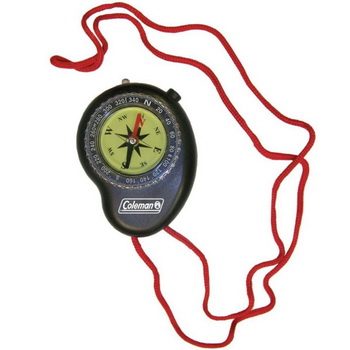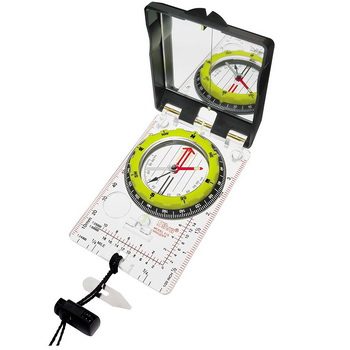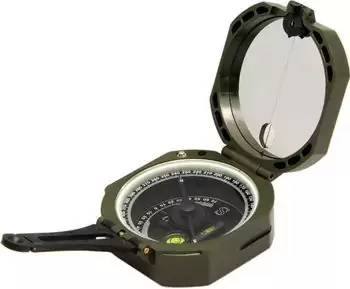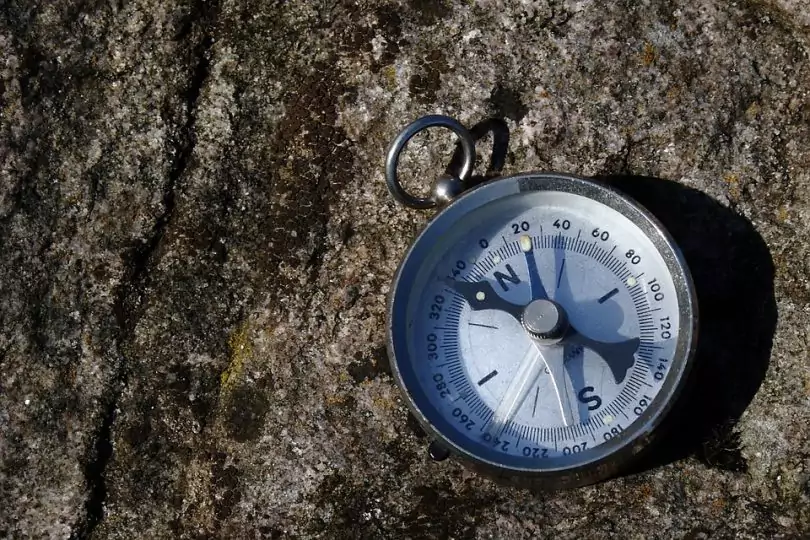You may think you’re a great outdoorsman, with years of experience under your belt. And it may be true, but even the hardened camper can get lost once in a while. Trees can easily look like one another, and before you know it, you’re heading down the wrong path.
That’s why having the best compass on your side can make all the difference in the world. You need something that’s not only reliable, but can withstand the harsh elements of nature as well.
The technology of GPS has definitely changed the world of hiking and camping. It’s made it a lot easier for a person to track where they’ve been so that they can follow the same paths back. However, GPS units use batteries, and those never last forever.
So don’t put all of your faith in one product; having a compass as a handy backup will ensure that you’re always on the right path. But what should you be looking for, exactly?
| Product Name | Weight | Size | Special Features | Price |
|---|---|---|---|---|
| Eyeskey Military | 6.7 oz | 3.25 x 2.5 x 1.2 inches | Waterproof, shockproof, sighting window with sighting line, bubble level, luminescent North points | Check price on Amazon |
| Coleman LED | 1.6 oz | 3.8 x 7.7 x 0.9 inches | Push-button LED backlight, powered by two CR2016 coin-cell batteries, lanyard. | Check price on Amazon |
| Gerber Bear Grylls | 1.3 oz | 0.8 x 4.5 x 5.5 inches | Lanyard, luminescent points, zipper pull, durable plastic body. | Check price on Amazon |
| Silva Ranger 515 | 5.6 oz | 0.7 x 5.1 x 11.3 inches | Lminous points for night use, sighting mirrors, clinometer, map magnifier, declination adjustment | Check price on Amazon |
| Ueasy Lightweight | 0.32 oz | 2.2 x 3.4 x 4.3 inches | Bubble level, clinometer, sighting mirror with lubber line and sighting hole. | Check price on Amazon |
| ROC Gear Composite | 3.8 oz | 3.2 x 2.75 x 1.3 inches | Clinometer, adjustable declination, bubble level, adjustable sighting points. | Check price on Amazon |
| SE CC4580 | 3.7 oz | 3 x 2 x 5 inches | Lanyard, floating dial, bubble level, tripod screw hole, adjustable sighting lens | Check price on Amazon |
| Cammenga Phosphorescent | 26.4 oz | 1.8 x 5.7 x 7.8 inches | Waterproof, carrying pouch, belt clip, phosphorescent highlights, conversion ruler, sighting lens | Check price on Amazon |
Features to Consider Before Buying
When it comes to looking for the best compass for hiking, you want to be aware of the key features that will ensure you’re getting quality for every dollar. You may think that any compass would do, but you would be mistaken. Despite looking like a simple tool, there is a lot of hard work that’s put into making a compass that will prove to be reliable every single time, and last for the rest of your life.

Image Credit: eyeandpen.com
And even these aren’t made the same, with various kinds of floating needles and advanced features that will set them apart from each other. The main features you want to look for on a compass are:
- Fluid-filled housing
- Baseplate
- Ruler
- Measuring scale
- Magnifying glass
- Inclination scale
- Declination adjustments
If you’re confused by any of these terms, don’t worry. They’ll be explained later in this article so that you can fully understand what you should be looking for.
Kinds of Orienteering Compasses
The most basic compass has a liquid filled capsule with a magnetic needle inside that is attracted to the magnetic North. However, there are other kinds of traditional compasses on the market to consider:
Basic compasses: these are very affordable models, and are a very good choice for beginner hikers and backpackers. They provide only the most basic of information, and lack certain features, such as adjustments for declination.
Advanced compasses: these are in the middle-range of compasses, and have a few more features that can make travel a bit easier. They have mirrors and magnifiers that make navigation easier and more accurate, reducing the chances of you getting lost.

Accessory compass: possibly the cheapest kinds you’ll find on the market, and are only good for quick reference. They have no base plate, so you shouldn’t expect any serious navigation while using them.
There are also digital compasses that exist to make your life much easier, providing accurate readings, however, they do rely on batteries. They also require calibration before you can go hiking, and if you forget to do so, you could end up being more lost than you realize. If you do intend on getting a digital compass, be sure to familiarize yourself with it first before you head out backpacking.
Adjustment for declination
This is to account for the difference between true North and magnetic North. It can be aligned to reflect the magnetic declination in your area of travel so that your compass is always accurate. This is done by turning a small screw on the compass housing to offset the orienting arrow according to the declination of your area.

Image Credit: jeanurquharthighlandsandislandsmsp.com
This isn’t a feature that shouldn’t be messed with unless you know what you’re doing. If you happen to have a compass that has a fixed arrow, then you’ll have to do the math yourself and make manual adjustments for each new measurement in order to get an accurate reading.
Magnifying lens
This is mounted on the baseplate, and can help you to read the tiny map symbols instead of straining your eyes.
Sighting mirror
This is a fold-out surface of a compass that allow you to make accurate readings. When the mirror is partially open, you can sight through the small notch at the top of the device so you can see both your bearing and sight on a distant landmark. In emergency situations, it can double as a signaling device.
Luminescent indicators
The sun isn’t always going to be up when you need to use your compass; that’s why glow-in-the-dark indicators can make all the difference in the world.

Good quality compasses will have the indicators on the magnetized needle, both sides of orienteering arrow, as well as on the cardinal points of your compass.
Clinometer
This is helpful in helping you measure the vertical angle of a slope, which is particularly useful during the snowier months of the year to assess the possibility of an avalanche.
Global needle
This is really only useful for those who travel and venture into the Southern hemisphere. A compass that has been oriented in the Northern hemisphere will cause a needle to tilt or drag when taken across the equator.

A compass with a global needle, on the other hand, can compensate for these variations and spin freely, no matter which part of the world you’re in.
Lanyard
Helpful in keeping your compass handy, as well as preventing it from getting lost. Having these advanced features will certainly come at a higher price, so consider wisely when shopping around for the right compass for your needs.
Top Products on the Market
Now that you have some idea of what you should be looking for, here are just a few of the top rated compasses so that you have somewhere to start your search.
Eyeskey Military 
Price: Approx. $17
Size: 3.25 x 2.5 x 1.2 inches
Weight: 6.7 ounces
Specific features: Waterproof, shockproof, sighting window with sighting line, bubble level, luminescent North points, neck lanyard, nylon carry case with belt loop, clinometer.
Best use: Hiking, camping, backpacking.
Description: Eyeskey Military Compass has a lot to offer when it comes to navigating your surroundings. Coming in a traditional army green color, it possesses a lot of features that will keep your mind at ease as you go on your hike.
The sighting is a bit different from the traditional style, as there is no flip-up optic to peer through; instead, it uses a true optic sighting that allows you to read the internal compass card directly. The luminescent points do require some charging, either from direct sunlight or the light of a lamp in order to work.
It comes with a nylon carry case with a belt loop, making it quite easy to carry and use on the go. Simply attach it to your belt and take it out whenever you need, to then put it back into the case in a matter of minutes.
PROS:
- Waterproof
- A handy neck lanyard
CONS:
- Luminescent points require charging from direct light
Related: The TruePower 40-0455 Survival Whistle Keychain is commonly bought alongside the Eyeskey Compass, due to its usefulness and portability.
Coleman Led 
Price: Approx. $6
Size: 3.8 x 7.7 x 0.9 inches
Weight: 1.6 ounces
Specific features: Push-button LED backlight, powered by two CR2016 coin-cell batteries, lanyard.
Best use: Not for long camping trips, better for an in-city, in-home use.
Description: The Coleman LED Compass is definitely handy for when the sun’s already set and you need to see where you’re going. With the simple push of a button, the backlighting will illuminate the face of your compass for easy reading. But this feature comes with a price, and that’s the cost of additional batteries when they run out.
The coin-cell batteries are affordable and easy to come by, but it’s an additional thing on your list you’ll need to remember each time you go hiking to ensure that your compass will be there for you when you need it. It might be best to keep this one as a backup to be used after dark to prolong the life of the batteries.
On the upside, it is a very affordable compass, so even though the coin-cell batteries might be considered an additional expense, the price of the compass is very good.
PROS:
- Good lanyard
- Bigger than it looks
- Cheap
CONS:
- Needs batteries
Related: The Streamlight 61205 Battery is commonly bought alongside the compass to have spare batteries in case they are needed.
Gerber Bear Grylls 
Price: Approx. $18
Size: 0.8 x 4.5 x 5.5 inches
Weight: 1.3 ounces
Specific features: Lanyard, luminescent points, zipper pull, durable plastic body
Best use: Backpacking, camping, hiking, everyday use.
Description: Gerber Bear Grylls Compass is quite compact and easy to carry; this is ideal for those who are looking to minimize the weight they carry while they’re backpacking. It’s one of the simpler compasses on this list, and is great for those who are just starting out and just need a reference point while they travel.
Being so compact and small, it fits anywhere, from backpacks to pockets to even any compartment inside the car. As a matter of fact, it comes with a loop that can be hanged to the car mirror if you plan to give it a day to day use or need some directions while driving.
The size makes it a preferred acquisition for those looking to save space. It doesn’t have a base plate or sighting plate, so it may be difficult to use this with a map effectively. Still, it’s pretty affordable, given the rugged nature of the compass itself.
PROS:
- Very compact and portable
CONS:
- Not very durable
- Not made with the best materials
Related: The Gerber Bear Grylls Micro Torch is a good add-on for the compass, as they’re both compact and have functions that compensate each other.
Silva Ranger 515 
Price: Approx. $41
Size: 0.7 x 5.1 x 11.3 inches
Weight: 5.6 ounces
Specific features: 0-Degree – 360-Degree dial with 2-Degree graduations, luminous points for night use, sighting mirror, clinometer, map magnifier, declination adjustment, lanyard, adjustable slider, screwdriver.
Best use: Hiking, camping, backpacking and more technical uses.
Description: If you’re looking for, taking technical and accurate measurements, Silva Ranger 515 is definitely the compass for you, and the price reflects what you’re paying for. These advanced features will keep you on the right path and ensure that you’re never lost.
The included declination adjustment allows to take the differences into account between the magnetic and true North, allowing you to maintain an accurate record of where you are and where you’ve been during your journey.
The map magnifier can be a great-added feature to the more old school or adventurous users who like traveling with older or more advanced maps. Furthermore, the luminous points can come in extremely handy for night use in case you need to move or continue walking.
This is definitely a more technical compass, hence the higher price. If you’re an experienced hiker or need it for any special use, it’s a great compass. Otherwise, paying the price for added features might not be the best idea for someone just looking for a compass that gets the job done.
PROS:
- Great extra features such as an added screwdriver, map magnifier, etc.
- Very reliable and durable
CONS:
- More expensive than a common compass
Related: The Silva Compass Case is perfect for keeping your compass safe and sound.
Ueasy Lightweight 
Price: Approx. $28
Size: 2.2 x 3.4 x 4.3 inches
Weight: 0.32 ounces
Specific features: Bubble level, clinometer, sighting mirror with lubber line and sighting hole.
Best use: Hiking, camping, backpacking, cross-country jogging.
Description: The Ueasy Lightweight Compass for Surveyors was designed to take a beating. The sighting hole serves as a protective cover for the compass, and makes it easier to store in a pocket or a backpack. Sadly, this doesn’t come with a lanyard option, making it a little more difficult to keep on hand.
However, the additional features definitely make the price worth it, as it provides you with the means to take accurate readings on the go.
It was initially designed for the specific tasks required by geologists, mining engineers and civil engineers, so it is a very reliable and strong compass, maybe even more durable and resistant than the traditional compass.
Plus, it is surprisingly lightweight for its quality, which makes it comfortable to carry around, especially on long trips, as you won’t even feel the weight. It will take longer than a Brunton to give a reading, but still it’s an extremely reliable compass and with great value for the price being paid for it.
PROS:
- Good price
- Lightweight
- Very resistant
CONS:
- No lanyard
- Not really waterproof (cannot be submerged)
Related: The Rite In The Rain 770F Notebook is commonly bought with the compass as many teachers use it or geologists that need to write down measurements or observations while on the move.
Roc Gear Composite 
Price: Approx. $139.95
Size: 3.2 x 2.75 x 1.3 inches
Weight: 3.8 ounces
Specific features: Clinometer, adjustable declination, bubble level, sighting mirror with lubber line and sighting hole, adjustable sighting points.
Best use: Traditionally used for more technical and scientific purposes, although also very good for camping.
Description: Professional geologists, surveyors and civil engineers use this. The ROC Gear Composite Pocket Compass is definitely not lacking in any department, on the contrary, it is full of features and very reliable. The polymer composite body is designed withstand a lot of punishment and keep on ticking, as long as you take care of it properly.
It has a direct-read capsule that has 1-degree resolution and 1/2 degree accuracy. The adjustable sighting points are also a plus, although one of the best features is definitely the sighting mirror with the sighting hole, quite comfortable and convenient for a consistent use.
It’s definitely on the higher end of compasses in regards to price, so unless you’re tired of using basic compasses, it’s definitely not one a beginning hiker should consider getting. Furthermore, it’s not the most lightweight of compasses, which is not ideal for people looking for camping or hiking at minimum weight.
PROS:
- Very professional and reliable
- Full of useful features
CONS:
- Expensive
Related: The BYB Bright Mini Aluminum Flashlight is a common add-on to the compass.
SE CC4580 
Price: Approx. $9
Size: 3 x 2 x 5 inches
Weight: 3.7 ounces
Specific features: Lanyard, floating dial, bubble level, tripod screw hole, adjustable sighting lens, sighting lines on cover, conversion chart, water-resistant nylon pouch.
Best use: Hiking, camping, backpacking.
Description: Professional compasses don’t always have to be so expensive; SE CC4580 Compass with Pouch provides you with all of the features you need at a very affordable price. The only thing missing is any luminescent features, but the advanced features more than make up for this absent feature.
The adjustable sighting lens is a very useful and cool feature, it enables you to view the target and the direction of at the same exact time, through the window. Also, the magnifier allows you to have a more precise reading. The thermoelastic liquid-filled capsule makes sure that the compass is able to withstand extreme changes in temperature and air pressure. Definitely great features for a very good price.
The lanyard allows you to wear your compass around your neck for easy access, and the nylon pouch is water-resistant so you can keep your compass dry no matter the elements you’re facing.
PROS:
- Good price
- Comes with a pouch
CONS:
- A bit heavy
Related: The SE Tanto Knife with Fire Starter is a common add-on for those who use the compass in camping trips.
Cammenga Phosphorescent 
Price: $55 – $65
Size: 1.8 x 5.7 x 7.8 inches
Weight: 6.4 ounces
Specific features: Waterproof, carrying pouch, belt clip, phosphorescent highlights, conversion ruler, sighting lens, lanyard.
Best use: Hiking, camping, backpacking.
Description: Cammenga Phosphorescent Lensatic Compass may look basic, but it’s built with a lot of features that definitely add to the price. Consumers of this product hail it for being very rugged, yet quite light, especially with how many features it comes with. Packaged in a dark military green color, even those who weren’t experts in taking measurements found this compass extremely easy to use.
It is also waterproof, which other compass’ aren’t. This is a good feature for the more adventurous campers, which might encounter high streams, or rain, in which other compasses would get damaged.
The phosphorescent luminosity is another cool feature for when waling, camping or simply being in the dark or in not so bright spots. It comes with a carrying pouch and a belt clip, both very handy features for portability and comfort when you need to use it. Simply clip it to your belt and you can use it any time.
PROS:
- Waterproof
- Very rugged
- Lightweight
- Good price
CONS:
- The locking mechanism might fail sometimes
Related: The US Military Style Coordinate Scale is usually an add-on with this compass.
Final Thoughts
Now you have a much better insight into which models on the market are the best and worth considering. We hope that we helped you make the right decision. But, despite it looking like a simple tool, precautions must be taken when using and storing your compass. Mistreating the device will lead to it not working properly, and won’t be much better than carrying around a lump of metal in your pocket.

Ensuring the lifetime of your compass doesn’t have to be a difficult task, but it’s one that should be taken seriously if you’re an avid hiker. Nothing is more worrisome than being lost in the woods with your only means of getting back not working properly. Take care of your compass, and it will take care of you.
Have any great compasses that we failed to mention here? Why not share some of your favorites with us in the comments below so we can have a more accurate list? Who knows, we may include your suggestions in a future article.








The Phosphorescent Lensatic Compass is definitely Made in the USA. It is sturdy, reliable, and of good quality. I didn’t want to spend too much money on the compass but I didn’t want a low quality product either like those liquid filled compasses that will eventually leak and get air bubbles. I have also used several compasses over the years and I also do not have very steady hands so I am pleased with the speed and efficiency in which this compass stabilizes. It may be a bit heavier than the average plastic compasses, but I will gladly carry this because it is a highly accurate compass that is easy to read, and best of all it will not die on you like a GPS system would when the batteries run out.
That compass is so easy to use and even newbies will find it user-friendly. It’s quite sturdy and most of all – waterproof! You’ll be assured that in any situation, it won’t die on you or let you down. It looks so basic and unobtrusive but don’t let that fool you. It’s a hard worker and a trusty friend.
This reminds of the time we went camping couple of years ago and forgot to bring a compass – it was not a very good experience. Since then I always double-check to be sure my Coleman Compass is packed. I find it really reliable and its LED Light comes in handy at night. Since that incident, I also pack a second compass for backup just in case.
That’s a great tip! Having a second compass for backup is the thing to do. The Coleman compass has batteries so it is a wise idea to have some batteries ready in case of battery drain.